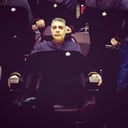What is, as of February 2020, the claim to fame of Lawrence Bragg (pictured)?
William Lawrence Bragg (1890-1971) was an Australian-born British physicist.
It seems that genetics may play their role here, as his father William Henry Bragg was also an eminent physicist (and Nobel laureate). But it was a childish accident which may well have led to their future eminence! Bragg junior, the subject of this question, broke his arm in a fall from his tricycle, and his father x-rayed it - the first documented instance of an x-ray being taken in Australia.
A precocious student, he started university when he was only 16, and when his father's work took him to Britain, he went with him, to study mathematics at Trinity College Cambridge, impressively taking the exam when confined to bed with pneumonia.
But it soon became clear that despite his prowess at mathematics, he was more interested in physics. His interest in x-rays, like his father's, went beyond their medical use, and the two of them researched x-ray crystallography, leading to the discovery that x-rays are waves. This led to the joint awarding to father and son of the 1915 Nobel Prize for physics, when he was only 25.
In World War 1 he put his skill to practical and military use, with research in sound ranging. The Bragg family was touched by the tragedy of war, as his brother perished at Gallipoli.
In 2014, the Pakistani campaigner for women's education, Malala Yousafzai won the Peace Prize aged 17, but Bragg remains the youngest winner of a Nobel science prize.
More Info:
en.wikipedia.org
